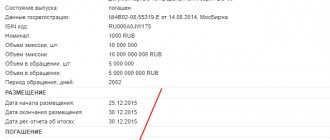Today, according to the Central Bank of the Russian Federation, the key rate is 8.5%
The Government has several financial instruments to influence banking policy. In order to influence the country's economy, it is necessary to take into account factors that help influence the level of interest rates on credit and deposit interest that develop in the country as a result of a market economy.
The Central Bank of the Russian Federation sets the interest rate at which it intends to lend to commercial banking structures. This is what is called the key rate .
Let's consider what it means, by what principles it is established, what it influences and how it differs from similar concepts, such as the refinancing rate.
Question: Is it possible to collect interest for the use of someone else’s funds (under Article 395 of the Civil Code of the Russian Federation), calculated based on the key rate of the Bank of Russia, and not on the refinancing rate? View answer
What is a key rate
The key rate is the main instrument of monetary policy of the country's financial sector regulator, the Bank of Russia (CBRF). The cost of money in the banking system depends on the key rate.
How it works. Since the Central Bank acts as a lender and borrower of last resort, the parameters of its operations determine the overall level of rates in the country's banking system. The key rate, in turn, is the reference point from which the parameters of operations are calculated: for credit - usually the rate is higher than the key rate (a certain premium is added), for deposits - slightly lower (taking into account a small discount).
At market rates, banks lend to each other and place excess liquidity with each other (free funds that the bank does not place on the market due to the risks of non-repayment). Usually they are within the range of the Central Bank rates, namely close to the key rate.
The ability to place excess liquidity in the Central Bank is an important mechanism for banks, since for significant amounts, even a small percentage on deposit transactions can reduce possible losses if these funds simply remained in bank accounts at 0%.
In extreme cases, as happens in Europe, the European Central Bank, for example, does not pay but charges interest for placing excess liquidity in its accounts, which in turn encourages banks to buy bonds and issue loans.
The key rate is an indicator on which the cost of money in the country depends for all participants in the economic process.
When the key rate changes - decreases or, conversely, increases - bank rates are often adjusted in the same direction.
The ratio of the key rate and average rates on deposits and loans (in rubles) for 2022 - early 2021.
| Period | Key rate | Average maximum rate on deposits in rubles for the period (10 largest banks by volume of deposits of individuals) | Average value for weighted average interest rates on loans provided to individuals for the period (both loans for a period of up to 1 year and over 1 year were taken into account) |
| 01.01 — 10.02.2020 | 6,25% | 5,765% | 13,51% |
| 10.02 — 27.04.2020 | 6,0% | 5,317% | 13,216% |
| 27.04 — 22.06.2020 | 5,5% | 5,125% | 12,83% |
| 22.06 — 27.07.2020 | 4,5% | 4.587% (above key) | 12,24% |
| 27.07.2020 — 22.03.2021 | 4,25% | 4.456% (above key) | 12,026% |
| Period | 01.01 — 10.02.2020 |
| Key rate | 6,25% |
| Average maximum rate on deposits in rubles for the period (10 largest banks by volume of deposits of individuals) | 5,765% |
| Average value for weighted average interest rates on loans provided to individuals for the period (both loans for a period of up to 1 year and over 1 year were taken into account) | 13,51% |
| Period | 10.02 — 27.04.2020 |
| Key rate | 6,0% |
| Average maximum rate on deposits in rubles for the period (10 largest banks by volume of deposits of individuals) | 5,317% |
| Average value for weighted average interest rates on loans provided to individuals for the period (both loans for a period of up to 1 year and over 1 year were taken into account) | 13,216% |
| Period | 27.04 — 22.06.2020 |
| Key rate | 5,5% |
| Average maximum rate on deposits in rubles for the period (10 largest banks by volume of deposits of individuals) | 5,125% |
| Average value for weighted average interest rates on loans provided to individuals for the period (both loans for a period of up to 1 year and over 1 year were taken into account) | 12,83% |
| Period | 22.06 — 27.07.2020 |
| Key rate | 4,5% |
| Average maximum rate on deposits in rubles for the period (10 largest banks by volume of deposits of individuals) | 4.587% (above key) |
| Average value for weighted average interest rates on loans provided to individuals for the period (both loans for a period of up to 1 year and over 1 year were taken into account) | 12,24% |
| Period | 27.07.2020 — 22.03.2021 |
| Key rate | 4,25% |
| Average maximum rate on deposits in rubles for the period (10 largest banks by volume of deposits of individuals) | 4.456% (above key) |
| Average value for weighted average interest rates on loans provided to individuals for the period (both loans for a period of up to 1 year and over 1 year were taken into account) | 12,026% |
The calculations included data from the Central Bank of the Russian Federation up to January 2022 inclusive. The table is compiled based on the dynamics of the maximum rate on deposits in the 10 largest banks in terms of the volume of attracted deposits from individuals, as well as indicators of the dynamics of the weighted average rates on loans provided to individuals for a period of up to 1 year and more than 1 year
Do not confuse the key rate and the refinancing rate
This is another economic instrument, also aimed at lending to commercial banks, but having a slightly different original meaning. Unlike the key one, for a long time it was of a reference nature and could not serve as an indicator of the state’s credit policy.
It has been used since 1992, having changed several official names:
- “single interest rate” - telegram of the Central Bank of Russia dated December 29, 1991 No. 216-91;
- “discount rate for centralized credit resources” - telegram of the Bank of Russia dated April 10, 1992 No. 84-92;
- “refinancing rate for commercial banks” - telegram of the Bank of Russia dated May 22, 1992 No. 01-156.
The refinancing rate is the percentage that the Central Bank uses when providing loans to other banking institutions. It was not tied to actual rates on certain banking transactions. Application, unlike the key one, was limited to the following areas:
- accrual of interest on deposits in rubles without income tax;
- calculation of tax penalties for late payments;
- basis of the tax base for tax on income from interest savings when using borrowed funds;
- to determine the interest on the loan, if it was not specified in the agreement.
IMPORTANT INFORMATION! From January 1, 2016, the refinancing rate was brought into line with the key rate, and as of today it is also equal to 8.5% per annum.
History of changes in the refinancing rate
| Period | Refinancing rate (%) | Regulatory document |
| 14.09.2012 — 31.12.2015 | 8,25 | Directive of the Bank of Russia dated September 13, 2012 N 2873-u |
| 26.12.2011 — 13.09.2012 | 8 | Directive of the Bank of Russia dated December 23, 2011 N 2758-U |
| 03.05.2011 — 25.12.2011 | 8,25 | Directive of the Bank of Russia dated April 29, 2011 N 2618-U |
| 28.02.2011 — 02.05.2011 | 8 | Directive of the Bank of Russia dated February 25, 2011 N 2583-U |
| 01.06.2010 — 27.02.2011 | 7,75 | Directive of the Bank of Russia dated May 31, 2010 N 2450-U |
| 30.04.2010 — 31.05.2010 | 8 | Directive of the Bank of Russia dated April 29, 2010 N 2439-U |
| 29.03.2010 — 29.04.2010 | 8,25 | Directive of the Bank of Russia dated March 26, 2010 N 2415-U |
| 24.02.2010 — 28.03.2010 | 8,5 | Directive of the Bank of Russia dated February 19, 2010 N 2399-U |
| 28.12.2009 — 23.02.2010 | 8,75 | Directive of the Bank of Russia dated December 25, 2009 N 2369-U |
| 25.11.2009 — 27.12.2009 | 9 | Directive of the Bank of Russia dated November 24, 2009 N 2336-U |
| 30.10.2009 — 24.11.2009 | 9,5 | Directive of the Bank of Russia dated October 29, 2009 N 2313-U |
| 30.09.2009 — 29.10.2009 | 10 | Directive of the Bank of Russia dated September 29, 2009 N 2299-U |
| 15.09.2009 — 29.09.2009 | 10,5 | Directive of the Bank of Russia dated September 14, 2009 N 2287-U |
| 10.08.2009 — 14.09.2009 | 10,75 | Directive of the Bank of Russia dated 07.08.2009 N 2270-U |
| 13.07.2009 — 09.08.2009 | 11 | Directive of the Bank of Russia dated July 10, 2009 N 2259-U |
| 05.06.2009 — 12.07.2009 | 11,5 | Directive of the Bank of Russia dated June 4, 2009 N 2247-U |
| 14.05.2009 — 04.06.2009 | 12 | Directive of the Bank of Russia dated May 13, 2009 N 2230-U |
| 24.04.2009 — 13.05.2009 | 12,5 | Directive of the Bank of Russia dated April 23, 2009 N 2222-U |
| 01.12.2008 — 23.04.2009 | 13 | Directive of the Bank of Russia dated November 28, 2008 N 2135-U |
| 12.11.2008 — 30.11.2008 | 12 | Directive of the Bank of Russia dated November 11, 2008 N 2123-U |
| 14.07.2008 — 11.11.2008 | 11 | Directive of the Bank of Russia dated July 11, 2008 N 2037-U |
| 10.06.2008 — 13.07.2008 | 10,75 | Directive of the Bank of Russia dated 06/09/2008 N 2022-U |
| 29.04.2008 — 09.06.2008 | 10,5 | Directive of the Bank of Russia dated April 28, 2008 N 1997-U |
| 04.02.2008 — 28.04.2008 | 10,25 | Directive of the Bank of Russia dated February 1, 2008 N 1975-U |
| 19.06.2007 — 03.02.2008 | 10 | Telegram of the Bank of Russia dated June 18, 2007 N 1839-U |
| 29.01.2007 — 18.06.2007 | 10,5 | Telegram of the Bank of Russia dated January 26, 2007 N 1788-U |
| 23.10.2006 — 28.01.2007 | 11 | Telegram of the Bank of Russia dated October 20, 2006 N 1734-U |
| 26.06.2006 — 22.10.2006 | 11,5 | Telegram of the Bank of Russia dated June 23, 2006 N 1696-U |
| 26.12.2005 — 25.06.2006 | 12 | Telegram of the Bank of Russia dated December 23, 2005 N 1643-U |
| 15.06.2004 — 25.12.2005 | 13 | Telegram of the Bank of Russia dated June 11, 2004 N 1443-U |
| 15.01.2004 — 14.06.2004 | 14 | Telegram of the Bank of Russia dated January 14, 2004 N 1372-U |
| 21.06.2003 — 14.01.2004 | 16 | Telegram of the Bank of Russia dated June 20, 2003 N 1296-U |
| 17.02.2003 — 20.06.2003 | 18 | Telegram of the Bank of Russia dated February 14, 2003 N 1250-U |
| 07.08.2002 — 16.02.2003 | 21 | Telegram of the Bank of Russia dated 06.08.2002 N 1185-U |
| 09.04.2002 — 06.08.2002 | 23 | Telegram of the Bank of Russia dated 04/08/2002 N 1133-U |
| 04.11.2000 — 08.04.2002 | 25 | Telegram of the Bank of Russia dated November 3, 2000 N 855-U |
| 10.07.2000 — 03.11.2000 | 28 | Telegram of the Bank of Russia dated 07.07.2000 N 818-U |
| 21.03.2000 — 09.07.2000 | 33 | Telegram of the Bank of Russia dated March 20, 2000 N 757-U |
| 07.03.2000 — 20.03.2000 | 38 | Telegram of the Bank of Russia dated March 6, 2000 N 753-U |
| 24.01.2000 — 06.03.2000 | 45 | Telegram of the Bank of Russia dated January 21, 2000 N 734-U |
| 10.06.1999 — 23.01.2000 | 55 | Telegram of the Bank of Russia dated 06/09/99 N 574-U |
| 24.07.1998 — 09.06.1999 | 60 | Telegram of the Bank of Russia dated July 24, 1998 N 298-U |
| 29.06.1998 — 23.07.1998 | 80 | Telegram of the Bank of Russia dated June 26, 1998 N 268-U |
| 05.06.1998 — 28.06.1998 | 60 | Telegram of the Bank of Russia dated 04.06.98 N 252-U |
| 27.05.1998 — 04.06.1998 | 150 | Telegram of the Bank of Russia dated May 27, 1998 N 241-U |
| 19.05.1998 — 26.05.1998 | 50 | Telegram of the Bank of Russia dated May 18, 1998 N 234-U |
| 16.03.1998 — 18.05.1998 | 30 | Telegram of the Bank of Russia dated March 13, 1998 N 185-U |
| 02.03.1998 — 15.03.1998 | 36 | Telegram of the Bank of Russia dated February 27, 1998 N 181-U |
| 17.02.1998 — 01.03.1998 | 39 | Telegram of the Bank of Russia dated 02.16.98 N 170-U |
| 02.02.1998 — 16.02.1998 | 42 | Telegram of the Bank of Russia dated January 30, 1998 N 154-U |
| 11.11.1997 — 01.02.1998 | 28 | Telegram of the Bank of Russia dated November 10, 1997 N 13-U |
| 06.10.1997 — 10.11.1997 | 21 | Telegram of the Bank of Russia dated 01.10.97 N 83-97 |
| 16.06.1997 — 05.10.1997 | 24 | Telegram of the Bank of Russia dated June 13, 1997 N 55-97 |
| 28.04.1997 — 15.06.1997 | 36 | Telegram of the Bank of Russia dated April 24, 1997 N 38-97 |
| 10.02.1997 — 27.04.1997 | 42 | Telegram of the Bank of Russia dated 02/07/97 N 9-97 |
| 02.12.1996 — 09.02.1997 | 48 | Telegram of the Bank of Russia dated November 29, 1996 N 142-96 |
| 21.10.1996 — 01.12.1996 | 60 | Telegram of the Bank of Russia dated October 18, 1996 N 129-96 |
| 19.08.1996 — 20.10.1996 | 80 | Telegram of the Bank of Russia dated August 16, 1996 N 109-96 |
| 24.07.1996 — 18.08.1996 | 110 | Telegram of the Bank of Russia dated July 23, 1996 N 107-96 |
| 10.02.1996 — 23.07.1996 | 120 | Telegram of the Bank of Russia dated 02/09/96 N 18-96 |
| 01.12.1995 — 09.02.1996 | 160 | Telegram of the Bank of Russia dated November 29, 1995 N 131-95 |
| 24.10.1995 — 30.11.1995 | 170 | Telegram of the Bank of Russia dated October 23, 1995 N 111-95 |
| 19.06.1995 — 23.10.1995 | 180 | Telegram of the Bank of Russia dated June 16, 1995 N 75-95 |
| 16.05.1995 — 18.06.1995 | 195 | Telegram of the Bank of Russia dated May 15, 1995 N 64-95 |
| 06.01.1995 — 15.05.1995 | 200 | Telegram of the Bank of Russia dated 05.01.95 N 3-95 |
| 17.11.1994 — 05.01.1995 | 180 | Telegram of the Bank of Russia dated November 16, 1994 N 199-94 |
| 12.10.1994 — 16.11.1994 | 170 | Telegram of the Bank of Russia dated October 11, 1994 N 192-94 |
| 23.08.1994 — 11.10.1994 | 130 | Telegram of the Bank of Russia dated August 22, 1994 N 165-94 |
| 01.08.1994 — 22.08.1994 | 150 | Telegram of the Bank of Russia dated July 29, 1994 N 156-94 |
| 30.06.1994 — 31.07.1994 | 155 | Telegram of the Bank of Russia dated June 29, 1994 N 144-94 |
| 22.06.1994 — 29.06.1994 | 170 | Telegram of the Bank of Russia dated June 21, 1994 N 137-94 |
| 02.06.1994 — 21.06.1994 | 185 | Telegram of the Bank of Russia dated 01.06.94 N 128-94 |
| 17.05.1994 — 01.06.1994 | 200 | Telegram of the Bank of Russia dated May 16, 1994 N 121-94 |
| 29.04.1994 — 16.05.1994 | 205 | Telegram of the Bank of Russia dated April 28, 1994 N 115-94 |
| 15.10.1993 — 28.04.1994 | 210 | Telegram of the Bank of Russia dated October 14, 1993 N 213-93 |
| 23.09.1993 — 14.10.1993 | 180 | Telegram of the Bank of Russia dated September 22, 1993 N 200-93 |
| 15.07.1993 — 22.09.1993 | 170 | Telegram of the Bank of Russia dated July 14, 1993 N 123-93 |
| 29.06.1993 — 14.07.1993 | 140 | Telegram of the Bank of Russia dated June 28, 1993 N 111-93 |
| 22.06.1993 — 28.06.1993 | 120 | Telegram of the Bank of Russia dated June 21, 1993 N 106-93 |
| 02.06.1993 — 21.06.1993 | 110 | Telegram of the Bank of Russia dated 01.06.93 N 91-93 |
| 30.03.1993 — 01.06.1993 | 100 | Telegram of the Bank of Russia dated March 29, 1993 N 52-93 |
| 23.05.1992 — 29.03.1993 | 80 | Telegram of the Bank of Russia dated 22.05.92 N 01-156 |
| 10.04.1992 — 22.05.1992 | 50 | Telegram of the Bank of Russia dated April 10, 1992 N 84-92 |
| 01.01.1992 — 09.04.1992 | 20 | Telegram of the Bank of Russia dated December 29, 1991 N 216-91 |
By the way, our special penalty calculator will help you find out the amount of penalties at the refinancing rate
Why does the Central Bank lower or raise the key rate?
The key rate is a policy instrument of the Bank of Russia, which allows you to influence inflation, or the process of depreciation of money. In this way, the Central Bank implements an inflation targeting policy, that is, it keeps it within acceptable ranges for the country’s financial system.
What is inflation
The inflation target for 2022 was 4%. But in reality the figure exceeded the expected value and amounted to 4.91%.
When the key rate decreases, the cost of money for banks also decreases. Therefore, loans for companies and individuals become cheaper, and deposits show lower returns. Saving money on deposits becomes unprofitable. The flow of funds into bank deposits is declining. And the issuance of loans, most often, on the contrary, is increasing.
With the money freed up, that is, not sent to deposits and received as loans, the population begins to spend more actively, as well as invest in the stock market. This is the stimulation of aggregate demand.
However, due to the increase in demand, prices also begin to rise. Since supply lags slightly behind demand (simply because it is sometimes impossible to quickly increase production and satisfy increased demand), the manufacturer will raise prices. Prices rise and inflation occurs.
In simple words: inflation leads to the fact that for the same amount of money a consumer can buy fewer goods and services than before.
Using quite complex models, the Central Bank determines the neutral level of the key rate - a level at which the economy is on the historical growth path, employment is close to full, and inflation is kept close to the target level. The neutral rate level is determined by a variety of macroeconomic variables: from demographics to labor productivity and economic structure. Taking into account the level of the neutral rate, the Central Bank determines monetary policy as stimulating, that is, when the key rate is set below the neutral level, or contracting, if it is higher. An excessively low key rate, like an excessively high one, is a sign of a stressful situation in the economy. A rate that is too low can “overheat” the economy, which is fraught with high inflation and the formation of “bubbles” in the markets. Too high a rate, on the contrary, can severely limit economic growth.
Dmitry Turmyshev
analyst at Gazprombank - Asset Management
If the key rate rises, the value of money rises. The more expensive it costs banks to raise funds, the more expensive they become for businesses and the public. Loans become more expensive, and accordingly, the demand for borrowed money falls. But saving increases - deposits become more attractive and allow you to earn more. Consumers spend less, demand declines, and manufacturers' sales volumes decline. If prices remain at the same levels, the business risks going bankrupt. To support demand, companies may reduce prices for their products. Thus, inflation slows down. However, this scheme does not work directly, especially in conditions of high market concentration and a large number of monopolies.
It is important for the Bank of Russia to maintain a reasonable balance, taking into account the maximum possible number of factors, predicting the consequences. Maintaining inflation growth rates within acceptable limits is one of the tasks that the financial regulator sets itself.
Comments: 17
Your comment (question) If you have questions about this article, you can tell us. Our team consists of only experienced experts and specialists with specialized education. We will try to help you in this topic:
Author of the article Dmitry Sysoev
Consultant, author Popovich Anna
Financial author Olga Pikhotskaya
- VLADIMIR
12/18/2021 at 16:36 HELLO!
I HEARD INFORMATION ABOUT THE CENTRAL BANK KEY RATE, WHERE IT SAID THAT ON DECEMBER 17 THE RATE WILL BE ESTABLISHED AT 8.5% PLUS 2% FOR DEPOSITS. WHAT DOES THIS MEAN? OR DID I UNDERSTAND SOMETHING WRONG? Reply ↓ - Elena
12/17/2021 at 21:46Hello! I don’t understand why they take tax on interest from a million and not higher. The cost of apartments is growing, which means a person will leave up to a million on deposit, and save the rest in a book or put it in a three-liter container. This is what my friends do who are saving for an apartment for themselves or for their children.
Reply ↓
- Tatiana
12/15/2021 at 16:08Hello ! Can you explain on the credit line whether the interest rate for using credit funds will rise after December 17 if the Central Bank raises the rate?
Reply ↓
Anna Popovich
12/16/2021 at 2:24 pmDear Tatyana, for existing loans - no. According to the Law “On Banks and Banking Activities”, a credit institution does not have the right to unilaterally change interest rates on loans and the procedure for determining them.
Reply ↓
08/17/2021 at 01:32
Hello. Will interest on bank deposits change due to the July increase in the key rate to .6.50%?
Reply ↓
- Anna Popovich
08/17/2021 at 01:55
Dear Sergey, some banks are planning to increase interest rates on deposits.
Reply ↓
07/05/2021 at 14:25
Why is the central bank rate taken into account in relation to 1 million, but interest income in the amount of 3 years of deposit storage is not taken into account? Why does it take 1 year? If there are three years and interest is calculated in one amount, then taxes should minus the rate multiplied by 1 million in each year, and not impose 13% on the amount received over three years. And the rate is edited about 5 times during the year, why is the arithmetic average rate not taken, but taken as of 01.01. There are a lot of questions in connection with the taxation of our accruals on deposits that neither tax authorities nor banks can answer. The bank has been using the DEPOSIT for 3 years and interest accrues every day on the accounts, only payment is made at the end of the term. Then the bank should break down the accrual of interest for each year, and not submit one amount due for payment. Moreover, during the period of opening accounts there were years, namely 2019 and 2022, which should not be taxed, because The law came into force in 2022. Then the accrued amounts must be minus from the payment amounts. And one last thing. If the amount is 600,000.00, why do the tax inspectorates apply these calculations to others?
Reply ↓
- Anonymous
12/14/2021 at 18:07
It depends on what percentage the deposit is placed at. Only the difference between accrued income and the non-taxable base is taxed. If there is a difference, then it’s 13% nonsense...
Reply ↓
06/12/2021 at 00:11
Yes... In February, analysts from VTB and Otkritie Bank, in March, analysts from Sberbank assumed that the rate would be 4.25% by the end of the year. On March 19, the rate was increased to 4.5%. On the same day, Kostin (VTB) suggested that the rate could rise to 4.75% by the end of 2022. On April 23, the Central Bank raised it to 5%, and today - to 5.5%. Analysts... They are only able to check, “Is everyone filled???”
Reply ↓
- Anna Popovich
06/14/2021 at 11:20
Dear Victor, analysts can only predict an event taking into account real and possible conditions. However, it is quite difficult to take into account only impending events, the factor of surprise, new sanctions and other things.
Reply ↓
06/05/2021 at 14:03
What is the non-taxable income on deposits in rubles as of 06/05/2021?
Reply ↓
- Anna Popovich
06/06/2021 at 09:38
Dear Igor, the total interest income on deposits (account balances) in Russian banks received by an individual for the year, minus non-taxable interest income, is subject to taxation. Non-taxable interest income is the product of 1 million rubles. on the key rate of the Bank of Russia.
Reply ↓
06/06/2021 at 12:11
For the entire year 2022, the amount of income of 42,500 rubles is not taxed.
Reply ↓
04/23/2021 at 23:18
How will the return on deposits change?
Reply ↓
- Olga Pikhotskaya
04/24/2021 at 01:28
Elena, hello. The Central Bank believes that an increase in the key rate should have a positive impact on deposit rates and slow down the flow of Russians’ funds from deposits to other forms of savings. VTB is also confident that the market will respond to the regulator’s decision to increase the key rate with a commensurate change in deposit rates.
Reply ↓
02/18/2021 at 17:58
and how is the tax calculated if the deposit is monthly capitalized and the key rate changes during the year of the taxable period
Reply ↓
- Klavdiya Treskova
02/18/2021 at 21:49
Dear Alexey, when calculating the taxable base for deposits, they take the value of the key rate as of January 1 of the reporting year. That is, when paying tax on profits received from deposits in 2021 and exceeding the established limit, the excess amount will be multiplied by 4.25. When paying tax for 2022, they will take the key rate that will be approved on January 1, 2022.
Reply ↓
How often can the key rate change?
The Board of Directors of the Bank of Russia makes decisions on the key rate eight times a year: at four key meetings and four intermediate ones. The dates of these meetings are published on the Central Bank website.
It is not necessary that the key rate will change every time. The board of directors may decide to leave it at its current level. Thus, from July 27, 2022 to March 21, 2022, the value of 4.25% per annum was in effect. On March 22, the decision to increase the key rate by 25 bp came into force, to 4.5% per annum - for the first time since 2022. On April 23, the Bank of Russia increased the rate by another 50 bp, to 5.0%. This value will be valid until the Bank of Russia decides to change it in one direction or another.
Results
The refinancing rate and the key rate were introduced as indicators involved in regulating credit relations between banks. They represent similar concepts (the amount of interest on debt obligations), characterizing different periods of validity: in the first case - a year, in the second - one week. Thanks to a shorter period of validity, the key rate introduced instead of the refinancing rate makes it possible not only to quickly respond to economic processes occurring in Russia, but also to influence the level of inflation.
From the Tax Code of the Russian Federation, which uses the value of the refinancing rate in a number of calculations, this indicator was not excluded due to the introduction of the key rate, which led to the emergence of a period of parallel establishment of the values of both rates. However, as of 01/01/2016, they are equalized - their value is established according to the rules applied for the key rate.
Sources:
- information from the Bank of Russia dated September 13, 2013
- Law “On compulsory social insurance against accidents...” dated July 24, 1998 No. 125-FZ
You can find more complete information on the topic in ConsultantPlus. Free trial access to the system for 2 days.
Stock market
A rate increase is generally a negative factor for the stock market.
At a low rate, there is a lot of “cheap” money, which allows you to invest more actively in riskier assets. Demand for shares is increasing, quotes are rising. Inexpensive loans for issuers are an additional source of funds for business development. When investment programs bear fruit, the company grows and investor confidence in its shares increases.
When the key rate rises, the opposite process occurs. It also affects the fact that rising money makes new loans less accessible for companies and increases the cost of servicing existing ones. This affects profits - they naturally decrease. Well, the size of profit indirectly affects both the company’s stock prices and directly influences decisions on the size of dividends.
Why not immediately reduce the key rate to the required level?
The state strives for its population and business environment to be active market participants. For example, citizens would take out loans for everything they need, businesses would also not need funds, and would make development plans for the near future.
Why not immediately reduce the key rate to the required level, since it has such a positive effect on the economy, as well as on the well-being of the population? As the experience of various countries whose governments sharply reduced the key rate has shown, this cannot be done.
Due to the low key rate, the value of the national currency sharply decreases. This happens due to the fact that the state's economy is not able to process and invest a large amount of available funds. The presence of such surpluses leads to an increase in the cost of various goods.
Therefore, we can say with confidence that the key rate is a regulator of excess demand
on goods and inflation.
Bond market
When the key rate increases, it becomes more profitable to buy fresh bond issues, since the yield on them is higher than on old ones. The fact is that the rules of the game in the debt market are very similar to those that apply to bank lending. Money becomes more expensive - companies raise funds on less favorable terms for themselves, that is, they issue bonds with a higher coupon. At the same time, existing issues are becoming cheaper: due to this, the profitability of old and new issues is getting closer.
When the key rate decreases, older issues, on the contrary, will be more attractive to investors than new ones. Therefore, their cost will increase until, again, the profitability of old and new issues is balanced.
The same will be true for mutual funds with bonds in the portfolio.
The investment portfolio can be protected from risks associated with changes in the key rate. If there are forecasts for its increase, it is advisable to purchase bonds with a floating coupon tied to the key rate. If it increases, the yield of securities will also increase, and therefore the profitability of the portfolio. If there are downward forecasts, it makes sense to buy long-term bonds with a constant coupon, since in this case they show a greater price increase.
Things to remember
- The key rate is an instrument of the Central Bank’s monetary policy. Its change affects the economy as a whole.
- Commercial bank rates on loans and deposits follow the key rate. Percentages decrease when decreasing and increase when increasing.
- The refinancing rate is equal to the key rate. Together they influence the size of various payments by the state.
- A reduction in the key rate stimulates economic development, while an increase slows it down.
- But it’s not just the key rate that influences the economy, so it’s still not worth focusing solely on it.
Currency market
When the key rate decreases, there is more national currency on the market. The demand for the ruble is decreasing, and accordingly, it is losing value. And not only in the domestic market (these are consequences of inflation), but also in relation to other currencies. This is due to the fact that foreign investors are experiencing unprofitable returns on assets in rubles (deposits, securities). They are transferred to other, more profitable instruments: they sell ruble assets (the ruble becomes cheaper due to high supply) and buy, for example, dollar assets (the dollar becomes more expensive against the ruble).
If the key rate increases, the opposite may happen. Ruble assets are becoming more attractive. Foreigners are buying up rubles, investing in Russian bonds and deposits, there is more currency, the demand for it is decreasing, but for the ruble, on the contrary, it is growing. Thus, the ruble strengthens against other currencies, for example, the dollar.
When the key rate increases, the national currency exchange rate strengthens. When it goes down, it’s the other way around.
Sometimes central banks are forced to sharply increase their key rate in order to contain the collapse of the national currency. This happened recently in Turkey. On March 18, the Central Bank of Turkey raised the key rate by 200 bp, to 19% per annum, in order to slow the rapid decline of the lira.
On December 16, 2014, the Bank of Russia made an unprecedented decision to immediately increase the key rate by 6.5 percentage points, to 17% per annum. This was an urgent measure to save the financial system in the face of a sharp collapse in the ruble exchange rate. Following the keynote, deposit rates jumped sharply. Thus, even some large banks offered deposits with a yield of 19-20% per annum (in a normal situation, such high rates are the lot of small and not the best banks, which have nothing else to attract depositors with). Those who managed to invest the maximum in deposits then managed to earn good money.
As a result, the volume of household funds in bank deposits in 2015, according to the Deposit Insurance Agency, increased by almost 4.7 trillion rubles. (in 2014 - almost 1.6 trillion rubles), up to 23.1 trillion rubles. In relative terms, the growth was 25.2% (in 2014 - 9.4%). The full version of the DIA study on the individual deposit market for 2015 can be found here.
The role of the refinancing rate
At the moment, the practical significance of SR is as follows:
- determines the need for taxation on deposits in domestic and foreign currency, if their percentage exceeds the SR by 5% (for deposits in foreign currency - by 9%);
- serves to calculate penalties accrued to pay tax fees (1/300 and 1/150);
- If the agreement or contract does not indicate the amount of liability or interest for failure to fulfill obligations, they are determined by the level of the Central Bank. For example, if you fail to pay for a service provided, you can collect interest for the use of someone else’s money under Art. 395 of the Civil Code of the Russian Federation precisely in the amount of SR per day of delay on the day of applying to a judicial authority for protection;
- is used when calculating the amount of penalties imposed on the administration of the employer (limited liability companies, joint stock companies, government agencies, individual entrepreneurs) for each day of delay in the payment of wages and other accruals to employees (1/300).
Briefly speaking
The key rate affects literally everything that happens in the economy. It is necessary to monitor its movements, since the state of your personal finances and the likelihood of making the right investment decisions also depend on this indicator.
| What's happening | Loan rates | Return on deposits | Inflation | National currency | Bond price | Bond yield | Stock market |
| The key rate is reduced | ⬇️ | ⬇️ | ⬆️ | ⬇️ | ⬆️ | ⬇️ | can grow on optimism |
| Key rate increases | ⬆️ | ⬆️ | slows down | strengthens | ⬇️ | ⬆️ | may be under pressure |
| Loan rates What's happening | |
| The key rate is reduced | ⬇️ |
| Key rate increases | ⬆️ |
| Return on deposits What's happening | |
| The key rate is reduced | ⬇️ |
| Key rate increases | ⬆️ |
| Inflation What's happening | |
| The key rate is reduced | ⬆️ |
| Key rate increases | slows down |
| National currency What's happening | |
| The key rate is reduced | ⬇️ |
| Key rate increases | strengthens |
| Bond prices What's going on | |
| The key rate is reduced | ⬆️ |
| Key rate increases | ⬇️ |
| Bond Yields What's Happening | |
| The key rate is reduced | ⬇️ |
| Key rate increases | ⬆️ |
| Stock market What's happening | |
| The key rate is reduced | may grow on investor optimism |
| Key rate increases | may be under pressure |
Inflation and its features
In order for the country's economy to develop steadily and in the right direction, it is necessary to keep inflation at a certain level. The lower it is, the more prospects the economy has: enterprises operate stably, and ordinary citizens do not have to fear that the currency of their state will depreciate.
For the Russian Federation, the government has set the optimal inflation level, it is 4
%. It is this level that can stabilize the situation on the economic market. If the inflation rate is lower, this may slow down economic growth, which will negatively affect the development of the state, as well as the financial situation of its citizens.
To ensure price stability in the state, the government pursues a rational monetary policy. In another way it is called monetary. The Central Bank is responsible for its implementation and correct execution of all rules. It is he who can declare (and in Russia has long ago declared) a certain rate of price growth as his goal. This policy is called inflation targeting
, and it is carried out in all civilized countries.
Inflation targeting is only possible if the target inflation rate is known.
This policy helps enterprises and other market participants quickly navigate any economic situation and develop a development and production plan.








